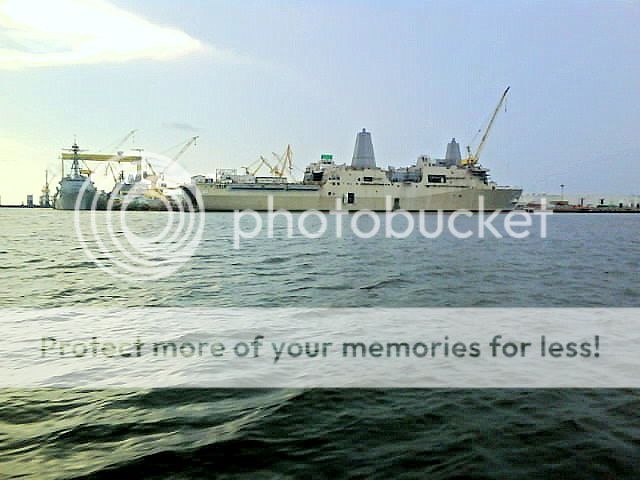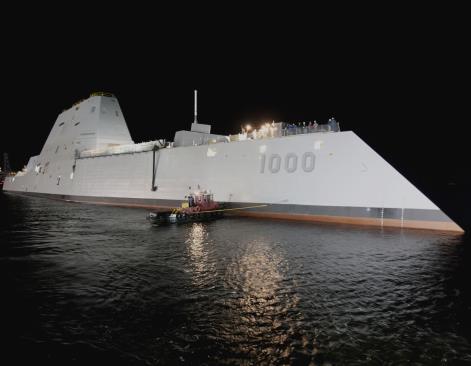It looks like you're using an Ad Blocker.
Please white-list or disable AboveTopSecret.com in your ad-blocking tool.
Thank you.
Some features of ATS will be disabled while you continue to use an ad-blocker.
share:
While I was in MS doing the oil cleanup for the B.P. disaster in 2010, I snapped this pic of one of our newest "stealth" ships being built by
Grumman, at the Singing river shipyard


Originally posted by C0bzz
The FAS page does not have a 400 NM fleet defence mission. My source gives 2.9 hours loiter at 130 nm with 3 external tanks and 6 AAM's, which isn't too far off FAS. My source also gives 805 nm radius with that same payload without any loiter. Perhaps there are differences in how this range is calculated.
Best i could find in my reading is the following:
With three 480 USG drop tanks, full internal fuel, combat and reserve fuel allowances, 8 x AIM-120 AMRAAMs and 2 x AIM-9 Sidewinders, the aircraft has a point intercept radius in excess of 650 NMI, with some assumptions made about expended missiles. This is radius performance in the class of the F-15C.
Like the F/A-18A-D, the F/A-18E/F was designed from the outset for a dual role fighter bomber mission environment. The enlarged wings have three hardpoints each, typically loaded with a pair of 480 USG tanks inboard and weapons on the pair of outboard stations. The wingtip Sidewinder rail is retained.
www.ausairpower.net...
Deck launched intercept F-14A - 915 nautical miles radius with two 280-gallon drop tanks jettisoned when empty
Deck launched intercept F-14D - 656 nautical miles radius combat range with two 280-gallon drop tanks
F-14D - With two 280-gallon drop tanks retained, 1,591 nautical miles ferry range
www.globalaircraft.org...
As the whole combat range is dependent on so many factors ( sometimes internal for one is cited against other with multiple drop tanks) perhaps we can instead agree that the F-14D is in terms of both empty and full weights still a 20% bigger plane, with exactly the same T/W with the F-18 having a higher internal fuel fraction. Best i can tell this is not reflected very well in combat radius but i am not sure if the swept wings, or which combination of aerodynamics factors, seemingly gives the F-14 something like range parity with only a third or so of the externally carried F-18 fuel potential.
My point is that the range of the F/A-18 E/F is not inferior to that of the F-14. In all likelihood it is superior due to greater relative fuel carriage capability. Actually the whole Super Hornet has poor range thing was borne years ago, likely from internet sources giving the range of a clean Super Hornet then claiming that this figure is the maximum possible range. It tends to bug me a little.
Suffice to say that given the F-18's ability to buddy tank ( it can apparently be flown in such a role with 5 480 gal tanks) and it's native load out of 3 480 gal tanks i believe that it SHOULD in fact have a greater effective combat range with such a large external fuel load. Having said that even with the 3 larger external tanks ( the 2 F14 EFT's only add 4000 LB for around 20 000 max) which gives the E/f's something like 22-23 000 lb , form base of something over 13 500, they do not seem to gain proportionately which will probably be explained by the drag and lowered T/W.
If the SH can not in practice exceed F-14 in point interdiction range but i would be surprised but even then the advantage may then be cancelled out by the shorter engagement range of the aim 120's and the lower high speed engagement potential...! I am sure i once knew more about this but i forgot to remember it all...
I agree that it is kinematically inferior to the F-14.
Yes, and given that it is a NEW plane ( It's not a upgrade in the sense that the F-14 D's was) should the navy not perhaps have gone with one of the potential upgrade versions for the F14D's or the same sort of 'upgrade' as the F-18 received?
Continued
I present to you the F21 Super Tomcat:
www.topedge.com...
www.anft.net...
So basically a super cruising upgrade to the F-14 which would have allowed the F-21 at least the strike and intercept capacity of the F-18's and IMO , form these articles, much much more than that; the F-14 was the frame to 'upgrade' , not the F-18.
Yes, the best argument in favor of the F-18 is the fact that it has replaced 3 or 4 other aircraft on carrier desks and succeeding in fulfilling all those roles much more than adequately. To expect such a multi role platform to match both the F-14 as fleet defense fighters, the A-6 as attack aircraft / tanker and to some extent the S-3 in both the tanker/SEAD type roles is ridiculous and it is certainly more than adequate if seen in this context.
I am not sure if multi role is really the best way to fight a 'real' war ( the US have not had one since the Korean war) but the US is not the only country moving in this direction so there may eventually be no great loss if it never has to fight large numbers of dedicated fighters or engage a major nations air defenses...
Stellar
Grumman proposed a few improved Super Tomcat versions. The first was the Quickstrike, which was an F-14D with navigational and targeting pods, additional attach points for weapons, and added ground attack capabilities to its radar. The Quickstrike was to fill the role of the A-6 Intruder after it was retired. This was not considered enough of an improvement by Congress, so the company shifted to the Super Tomcat 21 proposed design. The Super Tomcat 21 was a proposed lower cost alternative to the Navy Advanced Tactical Fighter (NATF). The Grumman design would have the same shape and body as the Tomcat, and an upgraded AN/APG-71 radar. New GE F110-129 engines were to provide a supercruise speed of Mach 1.3 and featured thrust vectoring nozzles. The version would have increased fuel capacity and modified control surfaces for improved takeoffs and lower landing approach speed. The Attack Super Tomcat 21 version was the last Super Tomcat proposed design. It added even more fuel capacity, more improvements to control surfaces, and possibly an Active Electronically Scanned Array (AESA) radar from the canceled A-12 attack aircraft.[75]
The last "Tomcat" variant was the ASF-14 (Advanced Strike Fighter-14), Grumman's replacement for the NATF concept. By all accounts, it would not be even remotely related to the previous Tomcats save in appearance, incorporating the new technology and design know-how from the Advanced Tactical Fighter (ATF) and Advanced Tactical Aircraft (ATA) programs. The ASF-14 would have been a new-build aircraft; however, its projected capabilities were not that much better than that of the (A)ST-21 variants.[76] In the end the Attack Super Tomcat was considered to be too costly. The Navy decided to pursue the cheaper F/A-18E/F Super Hornet to fill the fighter-attack role.[75]
en.wikipedia.org...
www.topedge.com...
www.anft.net...
So basically a super cruising upgrade to the F-14 which would have allowed the F-21 at least the strike and intercept capacity of the F-18's and IMO , form these articles, much much more than that; the F-14 was the frame to 'upgrade' , not the F-18.
seems to revolve around multirole strike fighters, so it doesn't seem like the USN cares about the loss of the F-14s capabilities.. Perhaps they feel the operational context that necessitated the F-14 doesn't exist anymore.edit on 2/9/13 by C0bzz because: (no reason given)
Yes, the best argument in favor of the F-18 is the fact that it has replaced 3 or 4 other aircraft on carrier desks and succeeding in fulfilling all those roles much more than adequately. To expect such a multi role platform to match both the F-14 as fleet defense fighters, the A-6 as attack aircraft / tanker and to some extent the S-3 in both the tanker/SEAD type roles is ridiculous and it is certainly more than adequate if seen in this context.
I am not sure if multi role is really the best way to fight a 'real' war ( the US have not had one since the Korean war) but the US is not the only country moving in this direction so there may eventually be no great loss if it never has to fight large numbers of dedicated fighters or engage a major nations air defenses...
Stellar
edit on 5-9-2013 by StellarX because: (no reason given)
Originally posted by lordpiney
While I was in MS doing the oil cleanup for the B.P. disaster in 2010, I snapped this pic of one of our newest "stealth" ships being built by Grumman, at the Singing river shipyard
That is a San Antonio Class LPD. While they have a reduced radar cross section, they are not exactly stealth ships.
There she is

And check out the irony
If you want more information on her
Link to more pictures and stats
Cody

And check out the irony
Ars Technica's Sean Gallagher has called the Linux-powered bridge a "floating data center" and likened it to the famous bridge on the Starship Enterprise. There are more than six million lines of code running the Zumwalt's on-board software, and futuristic touchscreens are fitted throughout the bridge. In many ways it's fitting that the first commanding officer will be one Captain James Kirk.
If you want more information on her
Link to more pictures and stats
Cody
new topics
-
Of course it was DEI
Dissecting Disinformation: 8 hours ago -
2nd Day Thanksgiving!...(leftovers!!)
General Chit Chat: 10 hours ago
top topics
-
Of course it was DEI
Dissecting Disinformation: 8 hours ago, 6 flags -
2nd Day Thanksgiving!...(leftovers!!)
General Chit Chat: 10 hours ago, 3 flags
